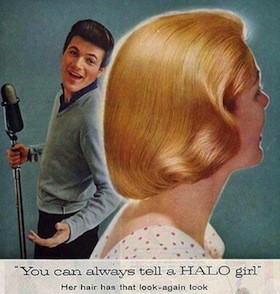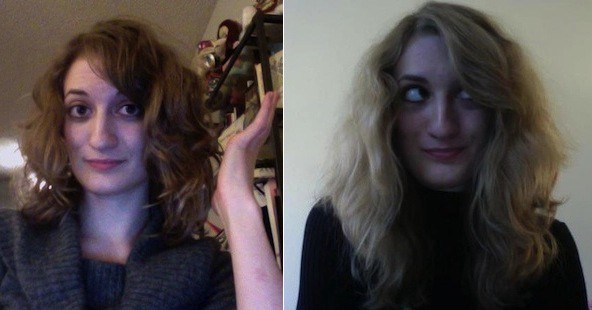What I’ve Learned From Three Years Without Shampoo

When I wrote about quitting shampoo over two and a half years ago, I was a relatively recent convert to the natural-hair game.
Here’s what I knew then: You go through a terrible phase where you don’t wash your hair at all. When that phase is over, you do the following instead of using shampoo: put baking soda in your hair, rinse it out, put apple-cider vinegar in your hair, rinse it out. Repeat once every 5–7 days, washing with just water in the meantime. Boom bam boom, the end.
That’s all still true, but now that I’m a seasoned veteran (kind of literally, because of the vinegar), I thought I’d divulge the seven most important lessons I’ve learned in the years since that first post.
1. Well, the first lesson is my hair looks ridiculously good now.
After about three years without shampoo, my hair is noticeably softer and fluffier than it used to be. I never use any product — I just blow-dry it with a finger diffuser and it stays in beautiful perfect waves all day. And when you know your hair looks great, it’s like a magical girl-power spell that grants you confidence and erases worries about the rest of your looks.
Something I didn’t anticipate is that my hair is also several shades blonder, to the point that people regularly ask me if it’s my natural hair color. It’s weird to realize that yes, it is my natural hair color, and the borderline-brown dirty blond from before was artificially darkened by shampoo. Or rather by grease that shampoo caused my scalp to overproduce, because the human body is a soggy box of horrors.
2. Quitting shampoo works because of science.
Remember pH from high-school chemistry class? If you don’t, here’s the tl;dr version. The pH scale goes from 0 to 14. Water sits in the middle with a neutral 7; anything below that is acidic and anything above is basic or alkaline. Human skin needs to be slightly acidic to prevent fungus and bacteria from colonizing your life. When you use baking soda (a base) and then apple-cider vinegar (an acid), your scalp’s pH remains stable and its oil production stays low. That’s why your hair keeps cleaner longer. (It’s also why you don’t use white vinegar: it’s too acidic.)
What’s tricky about this is that they intentionally manufacture shampoo to be slightly acidic — that’s what it means when you see stuff like “pH balanced” on the bottle. But some of the ingredients they usually use, particularly sulfates, will still strip away the oils from your hair, causing your scalp to overproduce oils despite the friendly pH. I don’t know. I got an A in high-school chemistry, but they didn’t cover hair-care products, the sexist pigs.
3. The magic ratio is 50/50.
Take a bottle and fill it with half baking soda, half water. Then take another bottle and fill it with half apple-cider vinegar, half water. Keep the bottles in your shower. This seems to be the optimal level of dilution — not too basic, not too acidic (though of course all our individual scalps require their own unique and disgusting balance of oils, fungus, and bacteria). Shake before using as the materials will separate. Use as much as you need.
4. The part of your hair that isn’t touching your head doesn’t really get dirty.
I mean, it does a little, and you do have to wash it, of course. But your scalp is where things are really happening (“things” = sebum blasting forth from your sebaceous glands). For both the baking soda and vinegar steps of the process, focus on the roots of your hair, not the tips. The bright side is that even if you haven’t washed your hair in a while, you can just wear a hat or even a wide headband — the rest of your hair will look more or less fine, because it’ll be all soft and fluffy from not using shampoo.

L: A few months in; R: A few years in.
5. The more you sweat, the more often you’ll need to wash your hair.
This one’s pretty self-explanatory. If you work out a lot, or live somewhere hot and humid, you’ll probably have to wash your hair more than once a week. But probably not more than twice a week.
6. Beautiful hair is at your fingertips.
Your fingernails are almost as important to the process as the baking soda and vinegar. They scrub your shampoo substitutes into your scalp and help clear a little hair gunk out when you’re just rinsing with water between washings. I apply my baking soda mix to a small section of my scalp, gently scratch it in, apply it to another small section, gently scratch it in, and continue like that until my whole head is covered. Same for the vinegar. You don’t have to have big long claws or anything. Mine are always bitten down to nubs, and they do the job just fine — though the vinegar stings like a whole hive of bees on freshly picked-at hangnails.
7. I have never failed the smell test.
There are two kinds of people in this world: those who will bury their noses in a stranger’s hair at a party, and those who won’t. I’ve encountered a lot of the former, and tempted a lot of the latter. It actually comes up pretty often because people compliment my hair all the time now (seriously, you guys, it looks so good!), and then I’m like, “Well, let me tell you a fun secret.”
Some people are content to take my word for it, but I am always happy to let anyone cuddle up and see for themselves that my hair doesn’t smell like vinegar. It doesn’t smell like pomegranate rainwater or whatever, either. It just smells like nice, neutral, clean hair. People are always surprised, but seriously, diluted apple-cider vinegar is way less gross than your body. Shampoo, on the other hand, just makes you grosser. Quit it. I dare you.
Previously: How to Quit Shampoo Without Becoming Disgusting
Top photo via kkanouse/flickr.
Lauren O’Neal is the Rumpus’s assistant editor. Her writing has appeared in publications like Slate, the New Inquiry, and Corium Magazine. She’s currently pursuing an MFA in creative writing in San Francisco. You can follow her on Twitter here.